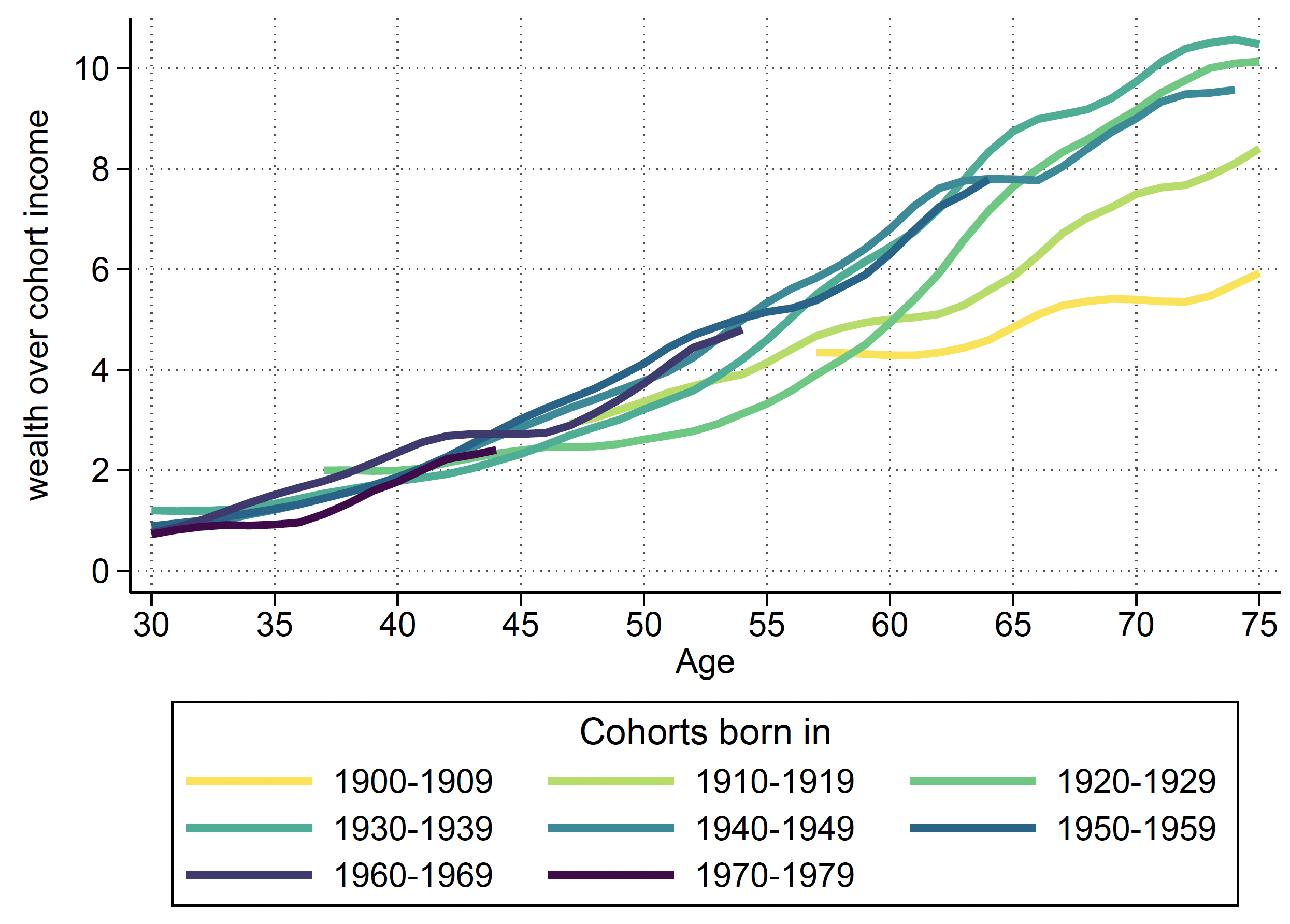Over the past four decades, rich countries have experienced a remarkable and much-debated increase in household wealth-to-income ratios and a surge in housing and equity prices. The development of these indicators has been linked to critical macroeconomic trends such as the decline in interest rates and in labour income shares (Piketty and Zucman 2013, Rachel and Smith 2016, Auclert et al. 2021, Mian et al. 2021b).
In recent research (Bauluz and Meyer 2024), we explore a fundamental aspect of these changes by examining the life-cycle wealth accumulation of different US birth cohorts such as millennials, baby boomers, and their predecessors. This allows us to study the history of life-cycle wealth and to shed light on the evolving patterns of aggregate wealth and saving over the past six decades. To this end, we construct a set of historical distributional financial accounts by harmonising the Survey of Consumer Finances Plus (Kuhn et al. 2018) – data that have been available since the 1950s – with official macroeconomic accounts.
Long-run trends in life-cycle wealth
Our examination begins by documenting key trends in the wealth accumulation of US cohorts born after 1900, unveiling two distinct patterns. First, in relation to their own incomes, newer cohorts retiring after the 1980s such as the baby boomers accumulate significantly more wealth by retirement age than their predecessors. In numbers, all cohorts start with roughly comparable wealth around age 30, but more recent cohorts experience about 50% higher wealth by age 65, rising from 5 to 6 times the cohorts’ own income to 8 to 9 times (Figure 1).
Figure 1 Life-cycle wealth-income ratio
However, this wealth increase predominantly reflects changes in the top half of the wealth distribution, especially among the top 10% of wealth holders within these cohorts. This trend has led to growing within-cohort inequality, as measured by the share of a cohort’s wealth owned by its wealthiest top 10% (Figure 2). As a result, we find that wealth inequality, both across age groups and within cohorts, has recently reached its post-WWII peak.
Figure 2 Share of wealth owned by the top 10% within cohorts over the life-cycle
Second, we uncover persistently stable post-retirement wealth over time. A well-documented phenomenon in recent decades is the minimal decrease in individuals’ wealth holdings after retirement – a behaviour termed the ‘retirement savings puzzle’ (De Nardi et al. 2015, French et al. 2023). Our analysis underscores that this behaviour is not exclusive to contemporary cohorts, but persists irrespective of the economic environment experienced by different cohorts upon retirement (Figure 3).
Figure 3 Average wealth over the life-cycle in constant dollars
Driving forces behind the shifts
How does this change in wealth accumulation come about? Our analysis pinpoints two drivers behind changing wealth patterns. To a large extent, the steeper age-wealth profiles of recent cohorts stem from significant capital gains in housing and equity markets since the 1980s. In contrast, older cohorts built their wealth primarily through saving. This distinction underlines the important role of rising asset prices in shaping modern wealth accumulation (Figure 4a).
Second, we observe a ‘life-cycle saving reshuffling’, meaning a shift towards increased saving during middle age, followed by decreased saving in old age (Figure 4b). While we see stable post-retirement wealth across cohorts, this does not imply a lack of dissaving among the elderly. In fact, recent cohorts engage in substantial dissaving amid positive valuation gains, in stark contrast to the slightly positive saving experienced by the older cohorts post-retirement. Conversely, during middle age, newer cohorts show higher saving compared to their predecessors.
Figure 4 Life-cycle capital gains and saving across 20-year birth cohorts
Looking at mechanisms, a standard life-cycle model in which the young save for retirement and the old dissave reconciles the previous facts with two empirical trends: longer life expectancy and growing income inequality. These trends increase the demand for assets by the young, increasing their price. This generates windfall gains for cohorts that have retired recently, such as the baby boomers. As they retire, their assets keep experiencing positive valuation gains, allowing for higher consumption in old age. As a result, the model generates an intergenerational wealth transfer from young buyers to old sellers in the form of higher capital gains (Fagereng et al. 2023).
Implications for macroeconomic aggregates
The changing patterns in life-cycle wealth have profound implications for our understanding of macroeconomic trends in household wealth and saving. Changes in these aggregates could reflect movements across three components: (1) life-cycle wealth or saving profiles; (2) the share of income allocated across population groups with different wealth or saving profiles; and (3) the size of each population group (young, middle-age, old), reflecting demographic changes.
Our analysis reveals that the rise in aggregate wealth-income ratios since 1980 can largely be understood as a steepening of the age-wealth profile among newer cohorts, alongside an increase in the income share received by the rich, who typically have high wealth-income ratios.
Moreover, we uncover a notable trend in private saving since the 1980s: the emergence of significant saving polarisation (Figure 5). While the middle-aged rich are saving more, there is a marked dissaving among the elderly, both rich and non-rich. The ‘life-cycle saving reshuffling’ we document explains nearly all the decline in saving among the elderly and approximately half of the increase among the middle-aged rich. Rising income inequality explains the remaining half.
Figure 5 Aggregate private saving decomposed across age-wealth groups, 1960–2016
In essence, we find that the ‘saving glut of the rich’ since the 1980s (as previously documented by Mian et al. 2021a, Saez and Zucman 2016, and Bauluz et al. 2022) is more accurately characterised as the ‘saving glut of the middle-aged rich', while dissaving by the elderly has emerged as the main force adding downward pressure on aggregate saving in recent years.
Recent work by Goodhart and Pradhan (2020) argues that demographic change may have a profound impact on financial markets: as the proportion of the retiree population expands and sells their assets, this would decrease aggregate saving, a phenomenon often referred to as an ‘asset market meltdown’ (Poterba 2001). Our research finds a significant increase in dissaving among the elderly in recent decades, but primarily operating through a novel channel: a reduction in their saving rates, which we link to the asset-price boom after 1980.
Conclusion
The main contribution of our paper is to examine the life-cycle wealth accumulation across cohorts in the US since 1960, revealing some striking facts. Wealth is rapidly aging. This is strongly linked to a steepening of the age-wealth profile, itself reflecting the asset-price boom since the 1980s. We further find a ‘life-cycle saving reshuffling’ in recent decades, with more saving occurring in middle age and less in old age. These trends have had a profound impact on aggregate wealth and saving, increasing aggregate wealth-income ratios and polarising private saving since the 1980s.
The rise in capital gains since the 1980s appears to be at the core of the change in life-cycle profiles, especially benefiting cohorts that have retired recently, such as the baby boomers. Meanwhile, younger generations, like millennials, are faced with significantly higher asset prices than their predecessors. This disparity poses a crucial question for policymakers: Is the evolving age-wealth profile a result of one-off capital gains, or is it here to stay?
References
Auclert, A, H Malmberg, F Martenet and M Rognlie (2021), “Demographics, Wealth, and Global Imbalances in the Twenty-First Century”, Working Paper.
Bauluz, L and T Meyer (2024), “The Wealth of Generations”, World Inequality Lab, Working Paper No. 2024/04.
Bauluz, L, F Novokmet and M Schularick (2022), “The Anatomy of the Global Saving Glut”, CEPR Discussion Paper No. DP17215.
De Nardi, M, E French and J B Jones (2015), “Savings After Retirement: A Survey”, VoxEU.org, 5 July.
Fagereng, A, M Gomez, E Gouin-Bonenfant, M Holm, B Moll and G Natvik (2023), “Asset-Price Redistribution”, Working Paper.
French, E, J Bailey Jones and R McGee (2023), “Why Do Retired Households Draw Down Their Wealth So Slowly?”, Journal of Economic Perspectives, 37(4): 91–114.
Goodhart, C A E and M Pradhan (2020), The great demographic reversal: Ageing societies, waning inequality, and an inflation revival, Springer Publishing.
Kuhn, M, M Schularick and U Steins (2018), “Asset prices and wealth inequality”, VoxEU.org, 9 August.
Mian, A, L Straub and A Sufi (2021), “The Saving Glut of the Rich”, Working Paper.
Mian, A, L Straub and A Sufi (2021), “What explains the decline in r? Rising income inequality versus demographic shifts”, Jackson Hole Economic Symposium.
Piketty, T and G Zucman (2013), “Capital is Back!”, VoxEU.org, 26 September.
Poterba, J M (2001), “Demographic structure and asset returns,” Review of Economics and Statistics 83(4): 565–84.
Rachel, L and T Smith (2016), “Towards a global narrative on long-term real interest rates”, VoxEU.org, 15 January.
Saez, E and G Zucman (2016), “Wealth inequality in the United States since 1913: Evidence from capitalized income tax data,” The Quarterly Journal of Economics 131(2): 519–78.






